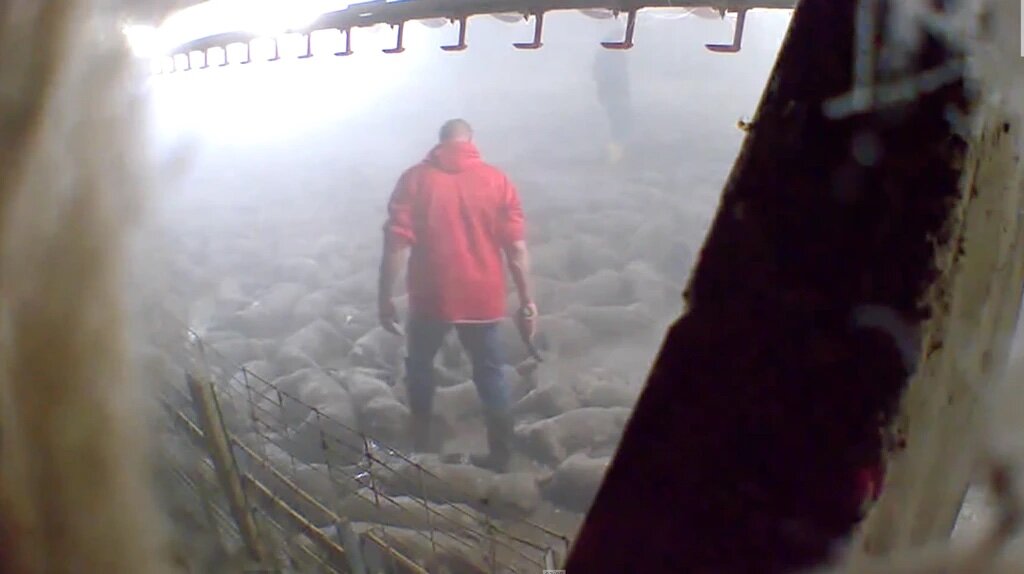The Letter About Ventilation Shutdown JAVMA Refuses to Publish
An Iowa Select Farms worker on May 19, 2020, carrying a gun in a barn after ventilation shutdown has been used to kill “excess” pigs. Still: DxE investigation
On August 15th 2021, the Journal of the American Veterinary Medical Association published a Special Report, detailing the implementation of ventilation shutdown to kill pigs, a method in which barns are closed off and steam is pumped in until they die of hyperthermia. Since then they have published articles that continue to defend the practice and many veterinarians, including me, wrote letters to the editor expressing our criticisms of ventilation shutdown.
I received a letter back from the Editor-in-Chief explaining how they have decided to stop the debate on this controversial subject and were no longer accepting any additional letters. I was invited to visit the AVMA website to learn more about the work being done regarding ventilation shutdown, and I was provided with a link to this page.
Below is my letter to the editor they declined to publish:
The Special Report in the recent issue of JAVMA outlining the killing of 243,016 pigs using ventilation shutdown was difficult to read. One can only imagine the psychological impact the veterinarians and employees faced, not to mention the intense and prolonged suffering the pigs endured. The report should serve as a call to our profession to address the animal welfare concerns within the animal agriculture industry.
Specifically, the AVMA should immediately reclassify ventilation shutdown as a “not recommended” form of depopulation.
The AVMA depopulation guidelines state that an effort must be made in the planning and execution to ensure animals “experience a rapid loss of consciousness” and are handled in “a humane manner” during depopulation. However, the special report illustrates the lack of forethought, planning, and misplaced priorities of an industry dependent on large-scale, intensive animal production practices. While the report indicates that “the farm had previously established a crisis management team and participated in mock animal disease outbreak exercises,” it did not take steps to ensure more humane, AVMA-approved methods of depopulation could be used. For example, the authors state that carbon dioxide was a preferred method for depopulation, but suppliers “could not provide the quantity of carbon dioxide needed because of regular customer demand.” It states “both captive bolt and gunshot were considered unfeasible because of a lack of availability of the necessary resources.” The decisions made by these farms to not stock and store essential items for a mass depopulation event illustrates management failures in preparedness.
The Report states that depopulation was necessary because of severe overcrowding, and under normal circumstances, each pig was only allotted only 6.8 sq. ft. of living space, so if confined to their pens past the date they were scheduled to be slaughtered, they would soon run out of space, and welfare would be further compromised. The World Organisation for Animal Health (OIE) recommends pigs be provided sufficient space for “separate lying and elimination areas,” a standard not met in this instance. To make matters worse, welfare concerns related to excessive stocking densities at a farm which implemented VSD+TH were reported by an employee whistleblower even prior to the Sars-CoV-2 outbreak.
We encourage the AVMA to focus on creating evidence-based policies and recommendations that improve the health and protect the welfare of the animals under our care. According to the report, the choice to kill pigs using VSD+TH was the direct result of poor planning, not due to a zoonotic or animal disease epidemic, natural disaster, or biosecurity concern. Further, the producers cited the fact that VSD+ was "permitted under constrained circumstances" by the AVMA as justification for their actions. We believe this deliberate misinterpretation of the AVMA Depopulation guidelines by pork producers without objection by the AVMA potentially encourages continued use of VSD+ in the future. If we do not take action as a profession to course correct, one can only imagine what future atrocities our profession will seek to rationalize.
1. Baysinger A, Senn M, Gebhardt J, et al. A case study of ventilation shutdown with the addition of high temperature and humidity for depopulation of pigs. J Am Vet Med Assoc 2021; 259:415-424
2. Direct Action Everywhere. Uncut, Unedited 2.5 Hour Audio of Pigs Being Roasted Alive Via "Ventilation Shutdown." YouTube. June 25, 2020. https://youtu.be/ybBTWIUeC6c.
3. Larkin, Melinda. Depopulation policy sent to expert panel for further consideration. AVMA. https://www.avma.org/journals/convention-newspaper/depopulation-policy-sent-expert-panel-further-consideration Published August 01, 2021
4. Leary S, Anthony R, Gwaltney-Brant S, et al. AVMA guidelines for the depopulation of animals: 2019 edition. Schaumburg, Ill: AVMA, 2019. Available at: https://www.avma.org/sites/default/files/resources/AVMA-Guidelines-for-the-Depopulation- of-Animals.pdf. Accessed August 25, 2021.
5. World Organization for Animal Health. Terrestrial Animal Health Code. Article 7.13.13. Space Allowance. https://www.oie.int/en/what-we-do/standards/codes-and-manuals/terrestrial-code-online-access/?id=169&L=1&htmfile=chapitre_aw_pigs.htm
6. Fang, Lee. After Pork Giant Was Exposed For Cruel Killings the FBI Pursued its Critics. The Intercept. Feb.17 202. https://theintercept.com/2021/02/17/fbi-iowa-select-pigs-whistleblower/

